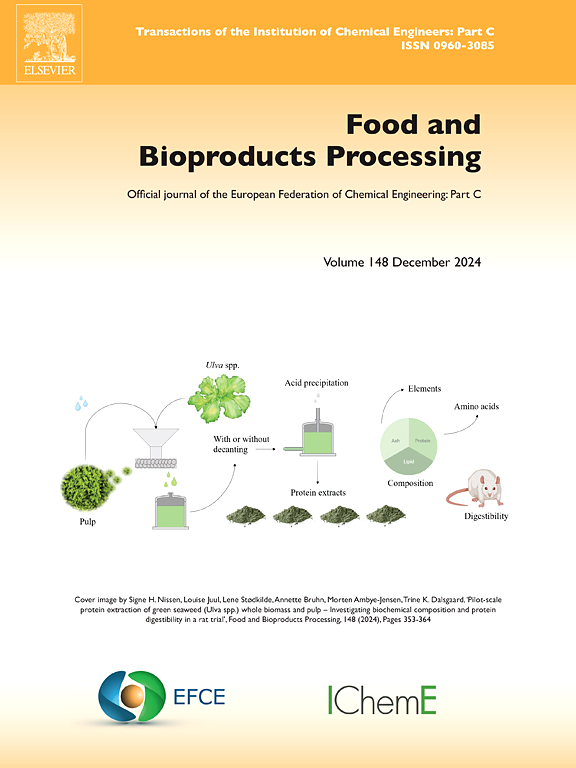Reducing of lipoxygenase and trypsin inhibitor in soy milk for improving nutritional quality through atmospheric cold plasma pretreated soybeans
IF 3.5
2区 农林科学
Q2 BIOTECHNOLOGY & APPLIED MICROBIOLOGY
引用次数: 0
Abstract
Soy is one of the most popular plant proteins. However, lipoxygenase (LOX) and trypsin inhibitor cause the undesirable beany odor and hinder trypsin activity. While thermal processing is commonly employed, it poses a risk of damaging heat-sensitive nutrients. To investigate the effects on lipoxygenase, trypsin inhibitor, and improve nutritional quality of soy milk, soybeans were treated with atmospheric cold plasma (ACP). After plasma treatment, lipoxygenase activity decreased by 97.82 %, and trypsin inhibitor activity decreased by 66 % from 61.56 TUI/mg to 20.72 TUI/mg. Additionally, the raw soy milk made from cold plasma-pretreated soybean showed a significant increase in gallic acid, genistein and antioxidant activity, resulting in reduced lipid and protein oxidation compared to thermal processing-treated sample. In conclusion, cold plasma treatment was effective in reducing lipoxygenase and trypsin inhibitor activities while maintaining heat-sensitive nutrients, which could be used in the production of soy and other plant-based products.
通过常压冷等离子体预处理大豆,减少豆奶中的脂氧合酶和胰蛋白酶抑制剂,提高营养质量
大豆是最受欢迎的植物蛋白之一。然而,脂肪氧化酶(LOX)和胰蛋白酶抑制剂会产生不良的豆腥味,并阻碍胰蛋白酶的活性。虽然热加工是常用的方法,但它会带来破坏热敏性营养物质的风险。为了研究脂氧合酶和胰蛋白酶抑制剂对豆奶的影响,并改善豆奶的营养质量,我们用常压冷等离子体(ACP)处理大豆。经等离子处理后,脂氧合酶活性降低了 97.82%,胰蛋白酶抑制剂活性降低了 66%,从 61.56 TUI/mg 降至 20.72 TUI/mg。此外,与热处理样品相比,用冷等离子体处理过的大豆制成的生豆奶中没食子酸、染料木素和抗氧化活性显著增加,从而减少了脂质和蛋白质的氧化。总之,冷等离子处理能有效降低脂氧合酶和胰蛋白酶抑制剂的活性,同时保持热敏感营养成分,可用于生产大豆和其他植物性产品。
本文章由计算机程序翻译,如有差异,请以英文原文为准。
求助全文
约1分钟内获得全文
求助全文
来源期刊

Food and Bioproducts Processing
工程技术-工程:化工
CiteScore
9.70
自引率
4.30%
发文量
115
审稿时长
24 days
期刊介绍:
Official Journal of the European Federation of Chemical Engineering:
Part C
FBP aims to be the principal international journal for publication of high quality, original papers in the branches of engineering and science dedicated to the safe processing of biological products. It is the only journal to exploit the synergy between biotechnology, bioprocessing and food engineering.
Papers showing how research results can be used in engineering design, and accounts of experimental or theoretical research work bringing new perspectives to established principles, highlighting unsolved problems or indicating directions for future research, are particularly welcome. Contributions that deal with new developments in equipment or processes and that can be given quantitative expression are encouraged. The journal is especially interested in papers that extend the boundaries of food and bioproducts processing.
The journal has a strong emphasis on the interface between engineering and food or bioproducts. Papers that are not likely to be published are those:
• Primarily concerned with food formulation
• That use experimental design techniques to obtain response surfaces but gain little insight from them
• That are empirical and ignore established mechanistic models, e.g., empirical drying curves
• That are primarily concerned about sensory evaluation and colour
• Concern the extraction, encapsulation and/or antioxidant activity of a specific biological material without providing insight that could be applied to a similar but different material,
• Containing only chemical analyses of biological materials.
 求助内容:
求助内容: 应助结果提醒方式:
应助结果提醒方式:


